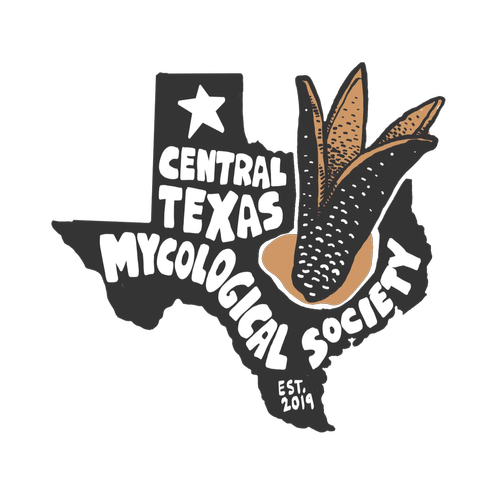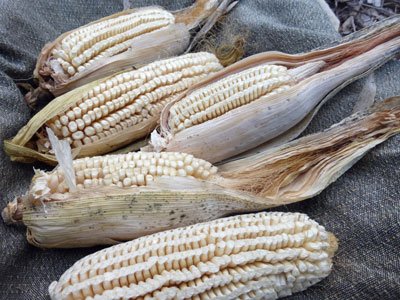Bring Huitlacoche to Your Garden
Texas Gourdseed Corn from Southern Exposure Seeds
If you are not in Central Texas, here are links to where we bought the seeds and the liquid culture.
The Central Texas Mycological Society (CTMS) is launching a new experimental crop, huitlacoche or Ustilago maydis. Like many of our mycological friends, huitlacoche straddles the line between a symbol of decay and a delicacy. To the corn farmers of the vast American plains, it is known as corn smut, a common and undesirable crop disease that forms in particularly hot humid summers. To the maize-centric cultures of Central Mexico, huitlacoche is a traditional part of the diet, a prized crop in itself, and a culinary delight. Much the same way that, for example, Chicken of the Woods is the object of many on a foray for a foraging mycologist but, to an arborist, is often a pathogen hollowing out the heartwood of a great old tree now not long for this world.
Ustilago maydis infects the ears of the corn primarily producing huitlacoche though it can also infect the tassel and stalk. Infection causes the kernels to form into distended darkened galls that are a culinary treasure though a blight to the producers. The majority of the resources referring to huitlacoche for US based institutions are written as profiles on diseases and pathology, for example the pages from Texas A&M Agrilife Extension and the Wisconsin University Horticulture Extension with passing references to its consumption. Such articles are detailed accounts of how to diagnose and avoid Corn Smut infection but, with a slight change in perspective of the reader, they become useful guides in how to induce smut formation.
CTMS has 3 plots of primarily Texas Gourdseed Corn around Central Texas designated for inoculation with huitlacoche liquid culture in 2023 including one test plot at the Zilker Botanical Garden as well as gardens of various members of the society including that of the author. To that end this guide is being compiled as well as a factsheet to facilitate cultivation by members like you. Currently most of this information is speculative and untested by CTMS; it is compiled from various reference sources in anticipation of our first trials and should be taken with a grain of salt, we are enthusiasts not experts in huitlacoche production.
If you want to try huitlacoche before you dive in (though there’s more to the experience of cultivation than just the eating) you can purchase it at a few different Mexican specialty markets and restaurants. Fresh huitlacoche is highly seasonal, coinciding with the corn season, so calling ahead is recommended before going to either a restaurant or market, however, some import the corn flash frozen and can stock it year round. If you’re in the Central Texas area, CTMS has compiled a map of restaurants that serve huitlacoche or have in the past, if you know of others, please let us know.
Starting in 2024, if you are interested in growing huitlacoche, contact CTMS, we have earmarked a portion of our harvest to be used to produce the spores to be distributed for future cultivation.
What do you need to grow Huitlacoche?
Hot and humid summers
A small area or few pots to grow corn
Liquid culture or spores of U. maydis
Picking your Corn variety
The first step to cultivating huitlacoche is growing corn. Texas Gourdseed was selected for the test plots of CTMS (alongside some other strains), an heirloom variety from Central and South Texas. It is drought and flood tolerant and disease resistant generally though susceptible to smut infection which represents a high probability of successful huitlacoche production Considering our lack of experience and lack of ancestral as well as institutional knowledge of huitlacoche production we have erred on the side of a successful harvest that perhaps may not an ideal one for a culinary experience.
The variety of corn affects the flavor of the resulting smut and since Texas Gourdseed is primarily a flour corn, the taste of the huitlacoche produced may be less palatable than the Central Mexican originals. Sweet corn and hybrids are often used among American producers and yield a sweeter, less traditional tasting huitlacoche. Varieties marketed as resistant to fungal infection should be avoided, including GMO varieties which are generally resistant.
If you are in Austin area, we are giving away Texas gourd seed corn seeds. Seeds available at the 78702 mushroom block pick-up until gone.
Plant Cultivation
Find a guide with a planting strategy that suits your needs. Fertilize, water, monitor, and generally care for the plants exactly how you would for a regular corn crop with one major exception. Most corn planting strategies are built around pollination, however for huitlacoche we do not actually want our plants to be pollinated. Huitlacoche infection is most effective before pollination occurs. This means that you don’t have to commit to a large corn crop like most of the growing guides will tell you. You can attempt to cultivate huitlacoche in pots, small raised beds, even window boxes if you don’t mind corn stalks blocking your window like prison bars. A surprising step in cultivating huitlacoche, unlike corn, is that you can even detassel the corn plants, preventing pollination.
The tassel is the male pollen producing portion of the corn plant. It grows at the very top of the plant and showers pollen upon the ears of corn below that take in the pollen via the silk that extends beyond the end of the ears. Detasseling is a common procedure to artificially select for corn plant genetics. By planting two varieties of corn side by side and detasseling one of them, you can assure hybridization in that corn as they must have been fertilized by the other tasseled variety. Detasseling is not required but it is an effective way to increase huitlacoche yield especially if you do not care about having a corn harvest. Which is an important caveat, if you choose to detassel your corn you will have no fully formed ears of corn. If you are trying to produce both, you simply need to be vigilant in your inoculation and make sure you are intervening early before the ears are pollinated.
If you want to try a mixed crop of corn and huitlacoche (or if you have a neighbor growing corn nearby that would expose your corn to tassels) shoot bags can be used to prevent pollination of some ears while leaving others available to produce corn. There are specialized shoot bags for corn as well as other crops that emphasize hybridization like cannabis production that are permeable to particles smaller than the size of the particular plants pollen allowing maximum ventilation for the plant. However this can be done with simple paper bags, waxed if there is rain or heavy dew in the forecast. We purchased our shoot bags from Seed Savers Exchange. Simply place the bag over the ear before the silk has emerged and pinch off a little to draw it tight to the stalk below the ear and secure it with a staple or paper clip in the loose flap of paper. You can even inoculate the ear by piercing the syringe through the bag if you want without risking exposing it to pollen in the open air.
Liquid culture
As is typical of many fungi, the individual galls of huitlacoche produce prodigious amounts of spores. Much like a common puffball mushroom, nearly the entire mass of the fruiting body (in this case, the galls on the ears) converts to spores so not many ears need to be reserved as seed.
There are many online guides for the production of Liquid culture (LC) that the reader can follow. We will link a few at the bottom of this article. For the purposes of the experiment, a 5% corn syrup (other sugars are perfectly acceptable) solution was sterilized in a pressure cooker and injected with LC syringes purchased from online vendors such as Miracle Farms and Mycelium Emporium. Although successful cultivation of Huitlacoche is a difficult endeavor, it is a good first experiment for those inexperienced in LC production as perfect sanitization is not required.
Typical mycelial cultivation which is done with sterilized jars or bags of cooked grain or wood pellet substrate, where the contents are dead and a perfect growing environment for any manner of infection that is introduced through the thin barrier separating the vulnerable substrate from the outside world, teeming with eager bacteria and spores. However, for huitlacoche, the substrate is a living ear of corn. Live corn has an intact innate immune system which offers partial protection against infection from poorly suited would-be invaders such as bacteria and molds. Secondly the manner of injection is inherently unsanitary as it will be performed in the garden, outdoors, exposed to the rich ecosystem of microorganisms of soil ecology and airborne spores and bacteria. This means that some basic, limited contamination of the LC reservoirs, while not ideal, does not render the LC useless as the corn can resist some infection.
Inoculation
When the ears of corn are approximately cigar sized around the time that the silk has emerged from the top of the ear they are ready for inoculation. You can do a simple test on a sample ear to ensure they have not been fertilized. This is not strictly necessary especially if you can ensure that there has been no exposure to tasseled corn within approximately ¼ mile.
Most huitlacoche grown in the US in small quantities is produced via liquid culture unlike in Central Mexico where spores are used. The most traditional method, employed since pre-columbian times is to take a sharp knife and successively dip it in a thick solution of spores and water and nick through the husks of unfertilized young ears of maize to produce infection. Modern producers in Central Mexico typically use syringes attached by hose to a reservoir of spore solution made with spores from previous harvests. Most producers in Mexico inject inoculant into the ears twice, a couple of inches from the top and bottom of the ears as seen in this video.
With liquid culture in the United States most small producers inject 5-10 ml of LC into the ear at the top, inserting the needle along the silk inline with the ear (silk channel inoculation) instead of through the side of the husk. For subsequent planting, the spores saved from previous harvests are generally used though some producers do continue to use LC.
The most important part of inoculation is that you want the spores or liquid culture to reach the entire ear top to bottom, for this reason multiple injections is recommended.
Harvest
Ears should be harvested once the galls have developed but before sporulation has occurred. Various time frames are given for this in different sources as local environmental effects as well as inoculation techniques can change the length of time necessary for development. LC develops faster than spores. Warm temperatures and higher humidities increase the speed of growth. Recommendations vary from 14-16 days to others stating 12-14 days is already too late. The essential point is to harvest before the galls have turned powdery inside. Once the spores have fully developed in a gall and began to turn powdery, consumption of that gall can cause considerable gastrointestinal upset.
The galls can be peeled or cut from the cob and refrigerated separately or on the cob for shorter periods. If you’re blessed by the maize gods with a successful crop of huitlacoche, there are some great recipes to try out. The most common is a huitlacoche quesadilla with sauteed huitlacoche, diced onions, and epazote inside. Simple and delicious. There’s no wrong way to enjoy it. From soups to tacos to traditional Mexican crepes even, so invite some friends over and get to cooking.






